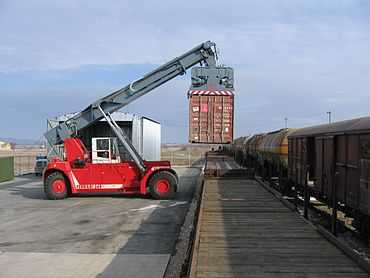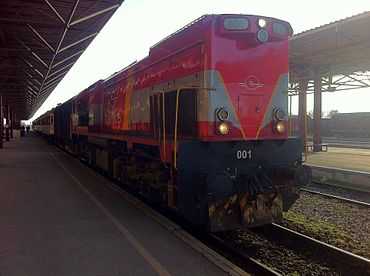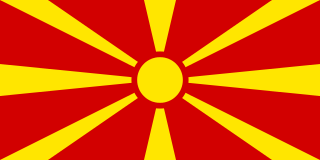Rail transportation in Kosovo
| Kosovo Railways Hekurudhat e Kosoves | |
|---|---|
 | |
| Locale | Kosovo |
| Dates of operation | 1874–present |
| Length | 333.951 kilometres (208 mi)<ref name=PREZENTIMI I BIZNESIT / HISTORIA></ref> |
| Headquarters | Fushë Kosovë, Kosovo |
| Website |
www infrakos |
The Railways of Kosovo in station territories take place from 333, 951 km (591 mi) up to 105,784 km (65,731 mi), whereas the industrial lines involve 103,4 km. The Railways of Kosovo are a property of the public sector where the state has access to ruling all administrative actions in the Ministry of Economic Development.[1]
History
In Kosovo, the construction of railways lines first took place in 1874 where the first railway line was built for the destination from Hani Elezit to Fushe Kosove and to Mitrovice. This was the beginning of launching the railway network around Kosovo and it became very significant for the transportation of travellers and goods. Also, it was equally important for the economic development of the country. Likewise, it enabled connectivity with other regions. With the construction of this railway line, railway transportation became amongst the busiest ones which led to opportunities for finding jobs for new railway lines. During 1934 the construction of this line proceeded in relation to a different direction such as that of Mitrovice - Leshak, in 1934 for Fushe Kosove - Prishtine, in 1936 Fushe Kosove - Peje, in 1949 Prishtina - Podujeve - Livadhi, and in 1963 Kline - Prizren.
On 27 September 1999 the Kosovo Train for Life charter train arrived in Pristina bringing aid and rolling-stock in connection with the Kosovo Force peace-keeping efforts.[2]
As of 2014 Kosovo railways stretch almost throughout the entire territory of Kosovo, with the exception of two cities - Gjilan and Gjakova.[3]
Trains
Railway transports, most importantly, are one of the safest transports in Kosovo. Infrastructures and motor vehicles are technically safer compared to other transports. Nevertheless, they are immune to tough weather conditions such as snow, rain, fog, and so forth. Additionally, railway transports are ecological as well since they are provided with fuel oil from "Diesel Electric" locomotives as their primary fuel source.
In Kosovo's railways there are eight Diesel locomotives and four Thermo Motoric ones. They have the capability to carry 17 wagons, 16 from which are for passengers and the remaining one is for luggage. The railways of Kosovo have a significant role for the transportation of travelers and goods. In 2005, there has been an estimation of 870 travelers per day who chose trains as a transportation tool. In 2006, there has been an increase by 26.56% more than in 2005, which means that there was a growth by 1100 travelers daily. In 2007, the number of passengers that have traveled with train in a day was 1143 or 3.91% more than in 2006. In 2008, there was a decrease in the number of travelers by 18.77% compared to 2007. The average number of travelers per day during 2009 was 1026 or 10.51% more than in 2008. Also, there has been an increase of travelers per day in 2010 by 1032 or 0.61% compared to 2009.[4]
Domestic Transport
Kosovo's railway transportations have the following daily schedules: The local train: travels every day from Peje to Prishtine and vice versa The free movement train: travels from Hani I Elezit to Fushe Kosove, and from Fushe Kosove to Gracanice and vice versa. Currently, this line is out of function.
International transport
For international transport, Kosovo Railways have a regular daily train, that is called "The fast train". This train travels once a day from Prishtine to Skopje and vice versa.[5]
Safety and Services

Kosovo railway transport is considered to be safer because all employees of the department of railway safety are highly and professionally trained, and their health care along with the physical and mental condition is also supervised. This is what makes the railway transport in Kosovo to be qualified as the safest one. Due to the statistical calculations that have been done in Kosovo, it has been declared that the railway transportation came up with lower death rates compared to the other transportations. Considering various customer categories and since Kosovo railway services share more than one market, there have been required some basic features that must belong to each of the customer category, and they are as follows:
-Transparency,
-Punctuality,
-Non-discriminant treatment.
Kosovo railways, during this year, will not only contribute in services of transporting goods and passengers, but they will also be improved in terms of the maintenance of the motoric vehicles. They will keep up with this commitment so that the customers will be satisfied with the services that Kosovo railways offer.[6]

Advantages
One other significant characteristic that separates and makes the railway transportation superior to the other ones is that the railway transportation has the capability to transmit a whole amount of large goods and passengers. One single locomotive may withdraw over 1200 tons. It is an irreplaceable utility for mining, commodities and for travelers, especially when it comes to longer distances. Railways possess many types of wagons which are designed for transporting goods such as oil, using containers and refrigerators as transporting tools and wagons that are used to carry grain and minerals. Currently, it is the most developed transportation in terms of goods being carried in train wagons.[7]
International Connections and Services

Kosovo railways through Leshak and Podujeve in the North and East side are connected with Serbia, while through Hani Elezi in South with Macedonia. East of Hani Elezit - Skpoje is in function with Macedonia while East of Serbia does not function at all.[8]
 Albania - No Connection
Albania - No Connection Montenegro - No Connection
Montenegro - No Connection Macedonia - open
Macedonia - open Serbia - closed
Serbia - closed
Statistics
| Year | Number of passengers | Revenues in EUR |
|---|---|---|
| 2013 | 276,852 | 179,515 |
| 2012 | 267,901 | 171,943 |
| 2011 | 279,330 | 193,593 |
| 2010 | 281,650 | 184,972 |
| Year | Tons of goods (Net) | Revenues in EUR |
|---|---|---|
| 2013 | 778,134 | 2,332,274 |
| 2012 | 488,539 | 1,601,675 |
| 2011 | 748,667 | 2,450,434 |
| 2010 | 877,332 | 2,864,370 |
References
- ↑ "Transporti". rks-gov.net. Retrieved 2014-03-02.
- ↑ "Kosovo aid train gets through". BBC News Online. 27 September 1999. Retrieved 17 October 2014.
- ↑ "RTK". rtklive.com. Retrieved 2014-03-02.
- ↑ "http://esk.rks-gov.net/publikimet/doc_download/1018-permbledhje-e-te-dhenave-te-transportit-dhe-telekomit-ne-kosove". esk.rks-gov.net. Retrieved 2014-03-02.
- ↑ "Hekurudhat". kosovorailway.com. Retrieved 2014-03-02.
- ↑ http://mzhe.rks-gov.net/npmnp/repository/docs/Plani_i_Biznesit_2012_te_NP_Infrakos_sha.pdf
- ↑ 7.0 7.1 http://www.trainkos.com/wp-content/uploads/2012/03/Plani-i-Biznesit-2013-Trainkos-Sh.A.pdf
- ↑ "Informata për Infrakos | INFRAKOS". infrakos.com. Retrieved 2014-03-02.
| ||||||||||||||||||